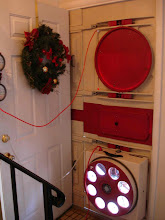On Maryland Energy Independence Day last July, I read an interview with a World Wildlife Fund researcher in The Washington Post. She said that from seeing the effects of climate change on animal habitat, she believes there is a five-to-seven year window for us to take action. I hope she is wrong and we have more time. Heck, I hope many things, but as Mel Brooks said, "Hope for the best and prepare for the worst."
So I plugged in my computer and looked for good ideas. I found my way to the U.S. Department of Energy's Green Power Network site and learned that we could power our house with renewable energy. I shared the good news with my husband, who like me was surprised and pleased that it's available in our state. Nobody told us! And we watch a lot of TV! I followed the links and chose a Green-e certified provider generating wind power in Maryland and neighboring Pennsylvania: http://www.commerceenergy.com. Using Commerce Energy's site, I quickly and easily switched our energy supply from Baltimore Gas & Electric (BGE)'s standard mix of 60% coal/30% nuclear/10% alternative to Commerce Energy's 100% wind-generated power.
When I compared the cost, it looked like it would be around $20-25 more monthly, but our contract has a fixed rate for one year. So it could be cheaper before long. Anyway, we had already reduced our energy costs more than enough to make up the difference. And making that decision felt good to us.
Commerce Energy notified BGE and our power switched over in September. BGE continues to distribute the power to us and bill us, so after that visit to Commerce Energy's Web site, we haven't had to do anything differently. We've been powered by wind for over seven months and our electricity is reliable and consistent, no different than before. And knowing what's behind it continues to feel really good.
4.29.2008
4.15.2008
58 Degrees & Comfy in Bed
For two Winters and a month into this last one, we turned our thermostat down to 67 degrees at the lowest for us to sleep comfortably upstairs. Then in January we had an energy audit that led to air-sealing a few big gaps and adding cellulose insulation to our attic. Ten days later, I gave a TV interview for NBC4 news that mentions we'd turned down our thermostat four degrees. But that's not where it stopped!

We turned down the thermostat one degree every few nights until we got down to 58 degrees. It's still true that it's a lot warmer upstairs than down (other suggestions from our audit should help with that): most winter days when we're home and evenings downstairs, 67 has been O.K. since the work. But with a blanket of 85% recycled paper above us, we've been cozy in our bed at nine degrees lower. And Spring came before we were finished experimenting!

For details on our audit, see Our Home Energy Audit and for a quick photo tour of the work, see Air Sealing & Insulation.

We turned down the thermostat one degree every few nights until we got down to 58 degrees. It's still true that it's a lot warmer upstairs than down (other suggestions from our audit should help with that): most winter days when we're home and evenings downstairs, 67 has been O.K. since the work. But with a blanket of 85% recycled paper above us, we've been cozy in our bed at nine degrees lower. And Spring came before we were finished experimenting!

For details on our audit, see Our Home Energy Audit and for a quick photo tour of the work, see Air Sealing & Insulation.
4.08.2008
A Cherry Blossom Break
4.01.2008
Dryer sheets that don't clog the filter

In May last year, we switched to cloth dryer "sheets". I read that the chemicals in most dryer sheets are toxic and potentially harmful to humans, and these cloth ones don't use chemicals. Somehow it's the weave that removes the static & makes the clothes softer. They are reusable for 500 loads. That's makes them cheaper, too. They also don't leave the residue that clogs the lint filter, the way most dryer sheets do, so they keep the dryer working efficiently. That's probably why these don't void dryer warranties. I bought them at http://www.staticeliminator.us. They are the two striped cloths in the photo.
In the summer and fall after we switched, they made the clothes soft and free of static. We did notice a bit more static in the winter. Our indoor air gets extremely dry in the winter. They still did an acceptable job, though. We could add some white vinegar to the wash, but I only did it a couple of times and then forgot about it, since the clothes, towels, sheets, napkins, and tablecloths have all been fine.
Subscribe to:
Comments (Atom)




